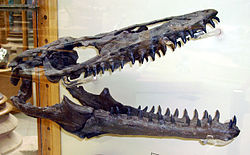The Cretaceous period is the ninth and longest period in the Phanerozoic eon, lasting 80 million years from 145 to 65 million years ago (mya). It followed the Jurassic period, and is the third and last period of the Mesozoic era. After it came the Cainozoic era.[1] The Cretaceous period has just two very long epochs:
- Upper Cretaceous 100.5 million years ago (mya) to 65 mya
- Lower Cretaceous 145.5 mya to 100.5 mya.


The Lower Cretaceous at ~45 million years, is the longest epoch in the Phanerozoic eon.
Though famous for its land fauna, the Cretaceous sea level rose much higher than today. North America was partly covered by an epicontinental inland sea, and half of Britain was under water. One account goes as follows: "During the Late Cretaceous (94–64 mya) sea level was up to 650 metres higher than at the start of the Albian, when it was perhaps about the same as it is today... The peak transgressions (sea levels) can be seen world-wide. There were rises of sea level of about 10–90 metres per m.y." [2]
In the Upper Cretaceous, chalk, a type of limestone, was laid down in warm shallow seas. Chalk is 95% to 99% made up of coccoliths, the calcium carbonate (CaCO3) plates which tiny single-celled algae (coccolithophorids) produce. At its end came the famous meteorite strike which, with the volcanic flood basalts spewed out in the Deccan Plateau (India), ended so many of the dominant life-forms: see K/T extinction event.
References
change